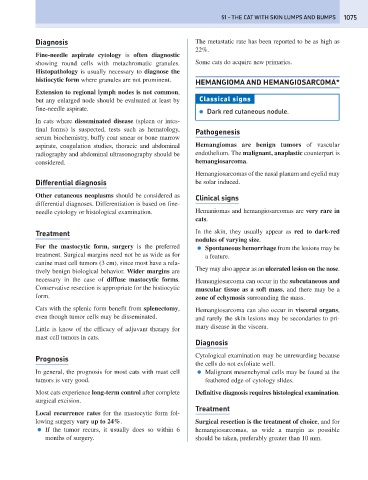Page 1083 - Problem-Based Feline Medicine
P. 1083
51 – THE CAT WITH SKIN LUMPS AND BUMPS 1075
Diagnosis The metastatic rate has been reported to be as high as
22%.
Fine-needle aspirate cytology is often diagnostic
showing round cells with metachromatic granules. Some cats do acquire new primaries.
Histopathology is usually necessary to diagnose the
histiocytic form where granules are not prominent. HEMANGIOMA AND HEMANGIOSARCOMA*
Extension to regional lymph nodes is not common,
but any enlarged node should be evaluated at least by Classical signs
fine-needle aspirate.
● Dark red cutaneous nodule.
In cats where disseminated disease (spleen or intes-
tinal forms) is suspected, tests such as hematology, Pathogenesis
serum biochemistry, buffy coat smear or bone marrow
aspirate, coagulation studies, thoracic and abdominal Hemangiomas are benign tumors of vascular
radiography and abdominal ultrasonography should be endothelium. The malignant, anaplastic counterpart is
considered. hemangiosarcoma.
Hemangiosarcomas of the nasal planum and eyelid may
Differential diagnosis be solar induced.
Other cutaneous neoplasms should be considered as Clinical signs
differential diagnoses. Differentiation is based on fine-
needle cytology or histological examination. Hemaniomas and hemangiosarcomas are very rare in
cats.
Treatment In the skin, they usually appear as red to dark-red
nodules of varying size.
For the mastocytic form, surgery is the preferred ● Spontaneous hemorrhage from the lesions may be
treatment. Surgical margins need not be as wide as for a feature.
canine mast cell tumors (3 cm), since most have a rela-
tively benign biological behavior. Wider margins are They may also appear as an ulcerated lesion on the nose.
necessary in the case of diffuse mastocytic forms. Hemangiosarcoma can occur in the subcutaneous and
Conservative resection is appropriate for the histiocytic muscular tissue as a soft mass, and there may be a
form. zone of echymosis surrounding the mass.
Cats with the splenic form benefit from splenectomy, Hemangiosarcoma can also occur in visceral organs,
even though tumor cells may be disseminated. and rarely the skin lesions may be secondaries to pri-
Little is know of the efficacy of adjuvant therapy for mary disease in the viscera.
mast cell tumors in cats.
Diagnosis
Cytological examination may be unrewarding because
Prognosis
the cells do not exfoliate well.
In general, the prognosis for most cats with mast cell ● Malignant mesenchymal cells may be found at the
tumors is very good. feathered edge of cytology slides.
Most cats experience long-term control after complete Definitive diagnosis requires histological examination.
surgical excision.
Treatment
Local recurrence rates for the mastocytic form fol-
lowing surgery vary up to 24%. Surgical resection is the treatment of choice, and for
● If the tumor recurs, it usually does so within 6 hemangiosarcomas, as wide a margin as possible
months of surgery. should be taken, preferably greater than 10 mm.

